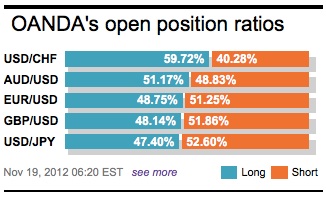There seems to be more of a positive attitude in the air this Monday morning on signs that US lawmakers are finding some common ground on deficit reduction efforts. Even the single currency has managed to strengthen despite traders keeping a wary eye on Greece ahead of tomorrows special Euro-group meeting. Investors seem to be bolstered by signs of compromise over budget negotiations between the US Democrats and Republicans to avert an automatic series of tax increases and spending cuts due early next year. The positive tone of late Friday trading has carried through the over night session and into this shortened holiday US trading week.
The policy event in Europe this week is Tuesday’s special Euro-group meeting. It is the markets understanding that a decision of funding of the extended Greek program will be taken. This peripheral country sorely requires the next tranche of financial aid. The market expects a positive outcome, however, disagreement and therefore a delay in aid disbursement is still possible and not beyond the reach of the methodically slow Eurocrats. The IMF’s “the real fix, not a quick fix’ Christine Lagarde, reiterates a desire for a Greek deal to be “rooted in reality, and not wishful thinking.” Germany’s Merkel, under a domestic election time watch, continues to opt for easier solutions.
The German Finance Minister, Schauble, has reiterated his objection to haircuts for the official sector, while some other ECB members suggest that the group should agree to fund Greece for the next two years and then follow this up with more official talks in 2015. This is the classic “kick the can down the road” syndrome. No one would be held responsible of making unpalatable decisions, especially the Germans as Merkel heads into an election year. Further delaying of treating the symptoms obviously will not sit well Lagarde and the IMF. Even the promise of a third bailout coupled with other widely talked about measure may not be sufficient to get the IMF to roll over and play along with the idea that Greek debt is ‘sustainable.’ The reality is that if the IMF caves into political attempts to delay haircuts then the IMF’s real authority is undermined. It would be difficult to understand what monitoring role Lagarde and company would be playing when the issue of Italy or Spain resurfaces.
There are a plethora of Central bank announcements this week, some rate decisions and some just minutes of their previous meetings. The Grand ‘Old Lady’ or the Bank of England delivers its minutes. Many expect the report to mirror the dovish tone of last week’s inflation report. The market wants more details on how the repayment of gilt coupons to the Treasury fed into the November policy decision, as mentioned by the Inflation Report. Do not be surprised to see the minutes reinforce the idea that QE remains the BoE’s monetary instrument of choice, rather than FLS. The sterling bulls continue to dominate, especially given the choice of the EUR.
The BoJ rate announcement is this evening, and even with their domestic political upheaval, many do not see any rate or QE action ahead of the December election. This is especially more so after increasing their AP program only a few weeks ago. The market is looking at additional moves by the Japanese authorities in the middle of next year. Perhaps they will change up the process and switch to an open ended open-ended framework with “operational targets being altered to certain monthly purchase amounts as well as strengthening of the forward guidance.” Any Japanese stimulus should influence the whole Asian region; have an effect on the Nikkei and currency pairs involving the JPY.
Perhaps we will get to hear why the market got it so wrong when the RBA produces its minutes tomorrow morning early. The market expects to be given some clarity into the surprise decision to keep rates on hold. Analysts are now suggesting that Aussie policymakers have signaled a pause and that the RBA will remain on the sidelines monitoring the effects of the previously undertaken easing. The market should pay close attention to Governor Steven’s speech. The unknown variable in the AUD scenario is China. Now that the economy is tentatively showing signs of stabilization and even strengthening should further support the Aussie bulls medium term target with a high 1.04 handle. The market should expect investors to begin kicking the ‘carry’ trade’s tires.

This morning’s EUR price has now recovered up to the high 1.2700’s, and very much against the short-trade positions. A plethora of stop-losses have been adjusted higher, towards the 200-MDA, just above the psychological 1.28 benchmark. The bears are hoping that the hourly studies remain in a ‘turnover process.’ In this scenario, coupled with the daily charts losing momentum, any pullback will be targeting last Friday’s low of 1.2691. However, do not be surprised to see that the bulls continue to find stop-losses so close so appealing to trigger. The EUR remains in its tight range and with a US holiday shortened week liquidity remains the markets number one concern.

Other Links:
Is the EUR Tired of Lofty Heights
This article is for general information purposes only. It is not investment advice or a solution to buy or sell securities. Opinions are the authors; not necessarily that of OANDA Corporation or any of its affiliates, subsidiaries, officers or directors. Leveraged trading is high risk and not suitable for all. You could lose all of your deposited funds.



